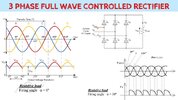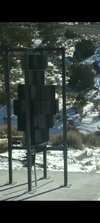I will start by thanking you for taking the time to view my post. I am a new member here so hello everyone!
I have a windmill that has an alternator/generator consisting of a rotor that has 16 permanent magnets and 36 stator windings.
There are 3 bridge rectifiers, each having one AC terminal connected to stator windings with the other AC terminal empty. (This is the confusing part...) and the +/- DC terminals of all three bridge rectifiers are collected in parallel for DC output.
I thought that the bridge rectifier AC input terminals should be connected together in this type of "phase-phase" rectification application. See image below.

This image shows what I expected to see however what I found in the unit didn't have the jumper/connection between the AC terminals of the bridge rectifiers. Each rectifier has one empty AC terminal.
My question is, wouldn't it be better to connect the AC input to the rectifiers as is indicated in the aforementioned schematic? or would this be a mistake? Wouldn't it provide less ripple in the DC output and more power?
I have a windmill that has an alternator/generator consisting of a rotor that has 16 permanent magnets and 36 stator windings.
There are 3 bridge rectifiers, each having one AC terminal connected to stator windings with the other AC terminal empty. (This is the confusing part...) and the +/- DC terminals of all three bridge rectifiers are collected in parallel for DC output.
I thought that the bridge rectifier AC input terminals should be connected together in this type of "phase-phase" rectification application. See image below.
This image shows what I expected to see however what I found in the unit didn't have the jumper/connection between the AC terminals of the bridge rectifiers. Each rectifier has one empty AC terminal.
My question is, wouldn't it be better to connect the AC input to the rectifiers as is indicated in the aforementioned schematic? or would this be a mistake? Wouldn't it provide less ripple in the DC output and more power?


